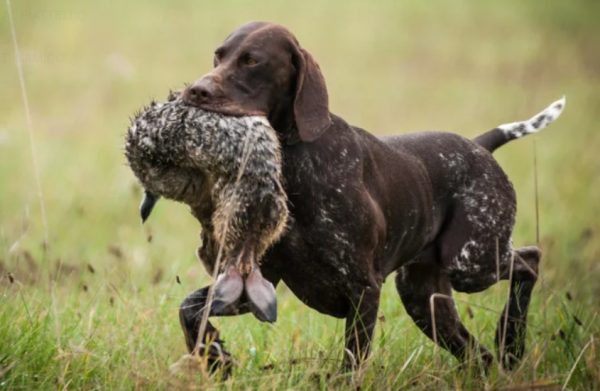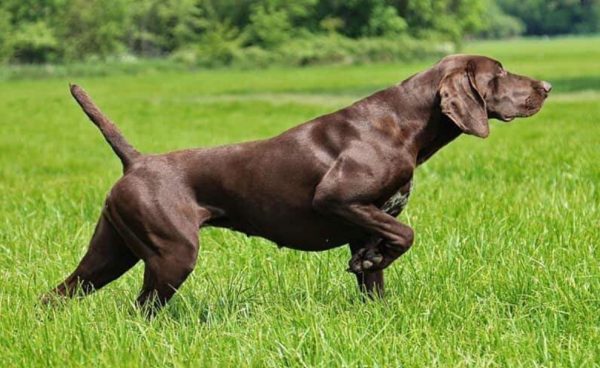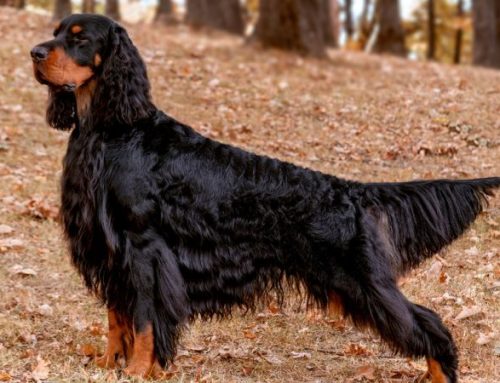The German Shorthaired Pointer and the German Wirehaired Pointer, two distinct variations of the German hunting dog, are among the most revered breeds in the world of hunting.
The German Wirehaired Pointer and the Shorthaired, known for their versatility and exceptional hunting abilities, represent the pinnacle of German canine breeding. While they share a common foundation, the Kurzhaar (German Shorthaired Pointer) and the Drahthaar (German Wirehaired Pointer) are distinguished by their physical characteristics and approach to work, each excelling in particular types of hunting.
The Origins of the German Hunting Dog
The roots of the German hunting dog trace back to the 18th century in Germany, where breeders and hunters set out to create a versatile hunting dog. This breed was intended to work in various environments and on different types of game, from small birds to large ungulates. The early breeding experiments involved Italo-French pointing dogs, Belgian pointing dogs, and possibly the Bloodhound. However, it was the introduction of “Pointer” blood that refined the physical structure and scenting ability of the German hunting dog, transforming it into the powerful and refined canine we know today.
Kurzhaar: The German Shorthaired Pointer
The Kurzhaar, or German Shorthaired Pointer, is an elegant, agile, and powerful dog. This breed embodies the perfect combination of speed, endurance, and precision, making it ideal for a wide range of hunts. The Kurzhaar’s hunting style is characterized by a smooth, consistent gallop that allows it to cover vast distances efficiently. The Kurzhaar is particularly prized in hunts for hares, quail, and woodcock, as well as pheasants and partridges, where its speed and keen nose make it an indispensable hunting companion.
The selection of the Kurzhaar has focused not only on its aesthetic appearance but also on the consistency and uniformity of its working style. This dog is distinguished by its continuous and energetic movement, yet it remains controlled, allowing it to slow down gradually when it detects game, never losing focus.
The character of the Kurzhaar is equally remarkable: it is a determined dog, with a “hunger” for hunting that drives it to give its all in every situation. It is loyal and forms a strong bond with the hunter, becoming not only an effective auxiliary but also a reliable companion.
The German Drahthaar: The Wirehaired Pointer
The Drahthaar, or German Wirehaired Pointer, is a more robust and resilient version of the German hunting dog. While the Kurzhaar is known for its elegance and speed, the Drahthaar stands out for its rough and bristly coat, which protects it from the elements and thorny underbrush during hunts in challenging terrains. This makes it particularly suited for hunting in more hostile environments, such as swamps, dense forests, and mountainous areas.
The Drahthaar is an extremely versatile dog, capable of tackling not only feathered game but also large ungulates. It is a strong and powerful dog, with a determined and independent character, yet deeply bonded to its owner. Thanks to its endurance and ability to work in difficult conditions, the Drahthaar is highly valued in boar hunting, where it can demonstrate its full strength and determination.
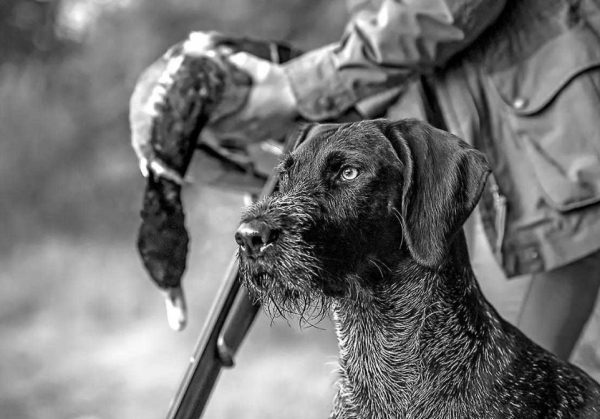
The German Drahthaar master of hunting
Distinctive Characteristics: Kurzhaar vs. Drahthaar
Although they share many qualities, the Kurzhaar and Drahthaar have significant differences that make them better suited to specific hunting situations.
- Appearance: The Kurzhaar has a short, smooth, and shiny coat that highlights its elegant and agile muscular structure. The Drahthaar, on the other hand, boasts a bristly and resistant coat, providing protection during hunts in difficult and adverse climatic conditions.
- Hunting Style: The Kurzhaar is faster and more agile, ideal for hunts requiring speed and precision, such as hunting hares or quail. The Drahthaar, with its more measured style and robustness, is perfect for hunts in tougher environments, such as boar hunting or waterfowl hunting.
- Character: The Kurzhaar is determined and loyal, with a strong work ethic and a close bond with the hunter. The Drahthaar, while also loyal, tends to be more independent and better suited to working autonomously, especially in challenging conditions.
The Hunter’s Emotional Journey with the German Pointers
For the hunter, the experience of working with a German Pointer is far more than a functional partnership; it is an emotional journey, a connection that transcends the physical act of hunting. As dawn breaks over the fields, the hunter and his dog set out together, moving as one through the mists of morning. The bond between them is almost palpable, forged through countless hours spent in the wild, navigating terrain and weather that would daunt less hardy souls.
With the Kurzhaar by his side, the hunter feels the thrill of the chase in every fiber of his being. The dog’s sleek form darts through the underbrush, its nose to the wind, every movement a testament to its lineage of precision and speed. When the game is near, the Kurzhaar’s fluid gallop transitions into a measured trot, its head held high as it locks onto the scent, leading the hunter closer with every step. The anticipation builds, the world narrows to the space between man, dog, and quarry, and in that moment, time seems to stand still.
The Drahthaar, with its rugged coat and indomitable spirit, brings a different kind of excitement. In the deep woods or over rugged mountainsides, where the elements test endurance and resolve, the Drahthaar proves its worth. Its powerful build and tireless energy make it a force of nature, undeterred by thorns or icy waters. As the hunter follows this formidable companion, there is a deep respect for the dog’s resilience, its ability to weather conditions that would send others back to the warmth of the hearth. Together, they face the challenge of the hunt, a team forged in the crucible of nature’s toughest tests.
The Weimaraner: A Unique Story
The Weimaraner, also known as the Weimar German Pointer, is one of the most fascinating and versatile hunting breeds in the world. Elegant, strong, and with an almost inexhaustible energy, the Weimaraner has captured the hearts of many hunters thanks to its incredible hunting skills and its ability to adapt to various types of game.
The origins of the Weimaraner date back to the 19th century in the German region of Thuringia, specifically at the court of Duke Karl August of Saxe-Weimar-Eisenach, from which it derives its name. This breed was developed with the goal of creating an all-purpose dog capable of excelling in both bird hunting and big game, such as deer and wild boar. The German nobles who selected these dogs sought a strong, resilient, and above all versatile hunting companion, able to work efficiently in both water and rugged terrains.
The Weimaraner is a medium-large dog with a slender yet muscular build that exudes both power and elegance. One of its most distinctive features is its unique silver-gray coat, which makes it easily recognizable. The coat can be short-haired, sleek, and close-fitting to the body, or long-haired, softer, with fringes on the limbs and tail.
The Weimaraner’s amber or gray-blue eyes give it an intelligent and alert expression, reflecting its curious and attentive nature. Its highly developed sense of smell and innate predatory instinct make it an extraordinarily suitable dog for hunting.
The Weimaraner is known for being a highly versatile hunting dog. Originally bred for big game hunting, today it is highly appreciated for bird hunting and, in particular, as a pointing dog. Its stamina makes it an ideal partner for long days in the field, while its intelligence and quick adaptability make it excellent even in complex hunting situations.
Additionally, its affinity for water makes it perfect for retrieving waterfowl. Its natural inclination to follow tracks and trails, combined with its exceptional nose, make it unrivaled in hunting species such as pheasants, partridges, woodcocks, and ducks.
The Weimaraner is extremely attached to its owner. It is loyal, affectionate, and eager to please, but it is also known for its intelligence and lively temperament. While these traits make it an exceptional hunting companion, they also require rigorous training and firm guidance.
The Weimaraner needs to be constantly stimulated, both physically and mentally. If neglected or insufficiently engaged, it can become restless and destructive. However, when well-trained, it is a balanced, obedient, and extraordinarily cooperative dog.
In modern hunting, the Weimaraner has shown its ability to adapt to a wide range of situations. It is perfect for wandering hunts, thanks to its endurance and ability to cover large areas of ground in a short time. Its point is steady and stylistically elegant, while its retrieve is quick and precise.
Furthermore, due to its agility and quickness, it is also used in certain types of driven hunts, where the dog must demonstrate speed and the ability to work in a team. Its versatility makes it ideal for hunters looking for a dog capable of excelling in various hunting disciplines.
The Weimaraner is not just a hunting dog, but an extraordinary life companion for anyone who loves spending time in nature. Its energy, courage, and intelligence make it perfect for any type of hunting, whether it’s pursuing game on hills, in forests, or along watercourses. However, the Weimaraner requires an owner who knows how to bring out its potential and offer it the right balance of work, training, and affection.
A Universal Hunting Companion
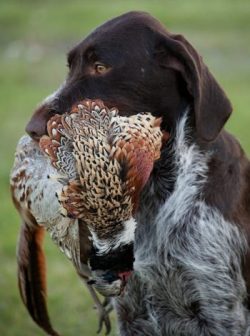
The Kurzhaar excels in open terrain, where it can use its speed and scenting ability to quickly locate and point out game. It is an ideal dog for those seeking an elegant and dynamic hunting companion that combines power and precision.
The Drahthaar, on the other hand, is the perfect companion for hunters who venture into more demanding environments. Its resilience and bristly coat make it well-suited to hunting in tough terrains, where it can demonstrate its full strength and determination.
The German Pointer: A Master of the Hunt
The German Pointer, whether in the form of the Kurzhaar or the Drahthaar, is far more than just a hunting dog. It is a true master of the hunt, a versatile and reliable auxiliary that has won the hearts of hunters worldwide with its extraordinary abilities and loyal character.
Whether chasing a hare across an open field or flushing out a boar from a dense forest, the German Pointer proves to be an irreplaceable hunting companion, capable of adapting to any situation and facing every challenge with courage and determination.
FAQs – German Wirehaired Pointer & German Shorthaired Pointer
Your ideal companions in field and forest
What is the main difference between a German Wirehaired Pointer and a German Shorthaired Pointer?
While both breeds share a similar purpose and German origin, they differ notably in appearance and coat. The German Wirehaired Pointer (Drahthaar) has a dense, weather-resistant wire coat and beard, ideal for rough terrain and cold climates. The German Shorthaired Pointer (Kurzhaar), on the other hand, has a sleek, short coat and is slightly more streamlined in appearance. Temperamentally, both are energetic, loyal, and intelligent, but some hunters find the Wirehaired slightly more independent.
Where are these breeds most commonly used for hunting?
Both breeds are prized across Europe, especially in Germany, Austria, Italy, and France, and are widely popular in North America, especially in the U.S. Midwest and parts of Canada. Their adaptability makes them suitable for varied game and terrains—from Alpine chukar hunts to pheasant drives in the English countryside, and duck blinds in the American South.
What makes them great for hunting?
Both are versatile gun dogs capable of pointing, retrieving, and tracking. The German Wirehaired Pointer excels in cold weather and harsh brush, thanks to its coat and grit. The German Shorthaired Pointer is slightly faster and lighter, perfect for open fields and dry climates. Both breeds have excellent noses, strong prey drive, and can work in both upland and waterfowl settings.
Are they suitable for first-time dog handlers?
Yes, but with some caveats. These dogs are highly intelligent and eager to learn, but they thrive with structure, consistency, and exercise. First-time handlers should be prepared to commit time to training and physical activity. They’re not couch potatoes—they’re athletes with a purpose.
How do these breeds behave in the home?
Surprisingly affectionate and loyal. The Kurzhaar tends to be more easygoing indoors and enjoys lounging after a day in the field. The Wirehaired Pointer can be more alert and protective, making it an excellent watchdog as well. Both bond deeply with their families and are generally good with children—though their energy needs must be met.
Which breed is better for mountain hunting or boar tracking?
The Wirehaired Pointer often wins here. Its rugged coat, strong build, and persistence make it ideal for mountainous terrains, thick brush, or wild boar tracking in Central Europe or Balkan forests. It’s also slightly more resistant to tough terrain and cold temperatures.
What kind of grooming do they need?
- Wirehaired Pointer: Requires hand-stripping or brushing several times per week to prevent matting and maintain coat texture.
- Shorthaired Pointer: Low maintenance; a weekly rubber brush or glove suffices.
Both require ear checks, especially after water retrieves, to avoid infections.
At what age can they start serious hunting training?
While basic obedience and exposure start as early as 8–10 weeks, focused hunting training usually begins around 6–8 months. These breeds mature mentally and physically fairly quickly, and benefit from early exposure to scent work, gunfire, and real field conditions.
What do they typically hunt?
Both breeds excel in:
- Upland game: pheasant, partridge, grouse, woodcock
- Waterfowl: duck, goose (especially with Wirehaired)
- Tracking: hare, fox, wild boar (particularly Wirehaired)
Their versatility makes them a favorite for hunters who pursue multiple species across different terrains.
Which climates suit each breed best?
German Wirehaired Pointer: Best in temperate to cold climates (Germany, Austria, North Italy, British Columbia).
German Shorthaired Pointer: Adaptable, but thrives in warmer or drier regions (Spain, southern France, U.S. plains, South Africa).
That said, both can adapt well with proper care.
How trainable are they?
Both breeds are exceptionally trainable, but respond best to positive reinforcement, clear leadership, and variety. Repetitive or overly harsh training styles can backfire. They’re thinkers—curious, sensitive, and quick learners. Many excel in field trials and NAVHDA tests.
What are their daily exercise needs?
These aren’t dogs for short walks. Expect to dedicate at least 1–2 hours a day for physical and mental exercise. Off-season, agility courses, scent games, swimming, and long runs keep them healthy and sharp. Boredom can lead to destruction or barking.
Are they good swimmers?
Yes, especially the German Wirehaired Pointer, which was specifically bred to retrieve in water. Its webbed feet and strong frame make it a solid swimmer. The Shorthaired is also good in water, though some individuals are more hesitant. Early introduction to water helps both breeds become confident retrievers.
Do they work well in hot weather?
The Shorthaired Pointer handles heat better due to its sleek coat. In hot climates (e.g., Andalusia, Arizona, South Africa), early morning or evening hunts are preferable. The Wirehaired’s dense coat makes it less ideal for high-heat environments but manageable with breaks and hydration.
What’s their hunting heritage?
Both breeds are deeply rooted in German hunting culture:
- The Kurzhaar was standardized in the 19th century as a true “all-rounder” for noble and common hunters alike.
- The Drahthaar was later developed to enhance durability, water work, and defensive qualities.
Both carry the spirit of European fieldcraft and conservation ethics.
Are they used in driven hunts or battues?
Yes. Especially the Wirehaired Pointer, which is fearless, driven, and vocal, making it ideal for boar battues or driven hunts in Italy, Bulgaria, and Germany. The Shorthaired is more silent and excels in pointing and steady retrieves.
Can I document my hunts with them?
Absolutely. Their elegant posture, intense gaze, and classic lines make them highly photogenic. Many hunters treasure portraits of their dogs on point amid foggy moors or golden forests. Some even film full hunts with GoPros to showcase teamwork.
Why choose Montefeltro for hunting with a Pointer in Europe?
Because at Montefeltro, the bond between hunter and dog is sacred. Our expert guides, deep knowledge of European hunting culture, and commitment to ethical sporting traditions ensure an experience where you and your dog grow together—in the field, in the mountains, and in memory.


